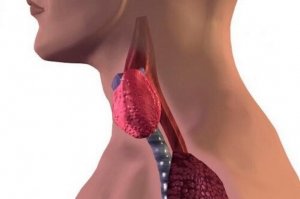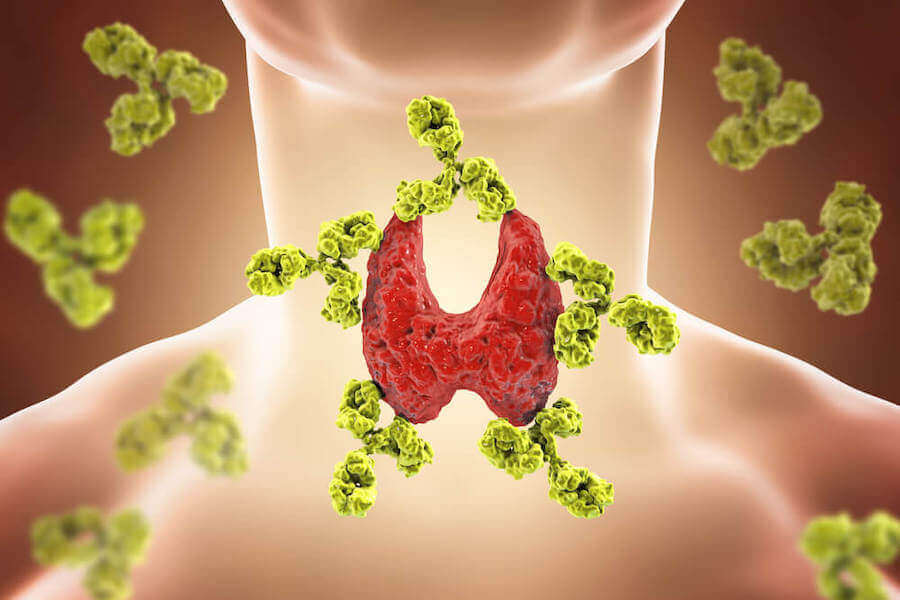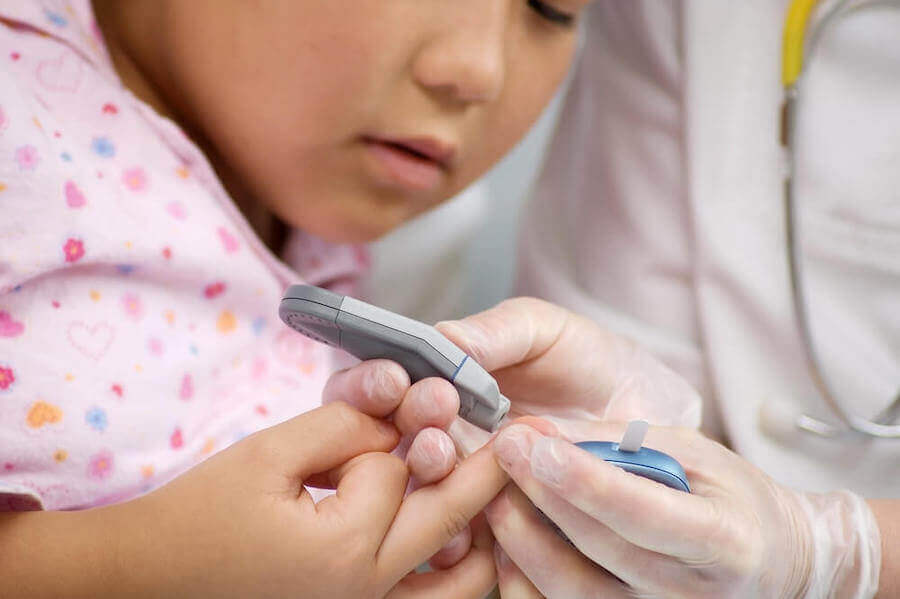Hashimoto's Disease in Children: Causes, Symptoms and Treatment

Did you know that Hashimoto’s Disease in children can seriously affect growth and development? Abnormal thyroid hormone levels affect the heart, muscles, brain, and other organs. Therefore, it’s important to know more about this disorder.
What is Hashimoto’s Disease in children?
Hashimoto’s Disease is where the immune system creates antibodies that attack the thyroid. Therefore, the immune system, which should protect against infections, attacks the thyroid. It makes the thyroid inflamed.
Over time, this inflammation reduces production of thyroid hormones. This leads to hypothyroidism, meaning that the hormone levels are lower than normal.

Generally, this disease more frequently affects middle-aged women. However, it can also affect men and boys.
This disorder is also known as autoimmune thyroiditis or Hashimoto’s Thyroiditis. It’s a common type of hypothyroidism in children. Generally, kids get it after they turn 6 months old.
Possible causes
So far, researchers don’t know why the immune system permanently damages the thyroid. However, many believe it’s due to both environmental factors and genetics. On the other hand, certain medications and substances can affect thyroid hormones.
Other causes could be consuming too much iodine. In addition, high cholesterol, and being around chemicals like pesticides are possible causes. In turn, not having enough vitamin D and changes in sex hormones can trigger this disease.
4 factors that increase risk
There are certain factors that increase Hashimoto’s Disease in children. Some of them are:
- Genetics. Kids with family members that have thyroid diseases are more likely to suffer from it.
- Autoimmune diseases, like type 1 diabetes, lupus, autoimmune hepatitis or rheumatoid arthritis.
- Congenital factors, like Down Syndrome.
- Exposure to radiation. For example, this happens to kids that received radiation therapy for cancer. It also includes those who have had excessive exposure to environmental radiation.

Common symptoms of Hashimoto’s Disease in children
The signs and symptoms may vary. At the beginning, this disease progresses very slowly. Some kids don’t show any symptoms at all. Therefore, it may take years for doctors to diagnose it.
The most common symptoms are:
- Stunted growth
- Brittle nails or dry, pale skin
- Hair loss
- Larger tongue than normal
- Depression, fatigue or irritability
- Constipation
- Delayed sexual development
- Sensitivity to cold
- Low heart rate
- Weight gain
Recommended treatment
Treating Hashimoto’s Disease in children is based on replacing the thyroid hormone with levothyroxine. This synthetic hormone normalizes the hormone levels in their blood. This way, kids and teens can grow and develop normally.
Not all children with Hashimoto’s Disease will have hypothyroidism. However, those who do develop it will need a lifelong treatment. All kids get different doses. Therefore, specialists will run tests to figure out the best dose.
If the dose isn’t enough, hypothyroidism can develop. However, if it’s too much, it can cause hyperthyroidism. We recommend seeing your doctor at least once a year. That way, he can monitor it.
If your child has trouble concentrating, sleeping, or is restless, go back to your doctor. These symptoms may mean that the dose is too high.
In conclusion, Hashimoto’s Disease in children doesn’t have a cure. However, your child can lead a completely normal life with the right treatment. Your doctor needs to strictly monitor and control that treatment. This way, your child will grow and develop healthily.
Did you know that Hashimoto’s Disease in children can seriously affect growth and development? Abnormal thyroid hormone levels affect the heart, muscles, brain, and other organs. Therefore, it’s important to know more about this disorder.
What is Hashimoto’s Disease in children?
Hashimoto’s Disease is where the immune system creates antibodies that attack the thyroid. Therefore, the immune system, which should protect against infections, attacks the thyroid. It makes the thyroid inflamed.
Over time, this inflammation reduces production of thyroid hormones. This leads to hypothyroidism, meaning that the hormone levels are lower than normal.

Generally, this disease more frequently affects middle-aged women. However, it can also affect men and boys.
This disorder is also known as autoimmune thyroiditis or Hashimoto’s Thyroiditis. It’s a common type of hypothyroidism in children. Generally, kids get it after they turn 6 months old.
Possible causes
So far, researchers don’t know why the immune system permanently damages the thyroid. However, many believe it’s due to both environmental factors and genetics. On the other hand, certain medications and substances can affect thyroid hormones.
Other causes could be consuming too much iodine. In addition, high cholesterol, and being around chemicals like pesticides are possible causes. In turn, not having enough vitamin D and changes in sex hormones can trigger this disease.
4 factors that increase risk
There are certain factors that increase Hashimoto’s Disease in children. Some of them are:
- Genetics. Kids with family members that have thyroid diseases are more likely to suffer from it.
- Autoimmune diseases, like type 1 diabetes, lupus, autoimmune hepatitis or rheumatoid arthritis.
- Congenital factors, like Down Syndrome.
- Exposure to radiation. For example, this happens to kids that received radiation therapy for cancer. It also includes those who have had excessive exposure to environmental radiation.

Common symptoms of Hashimoto’s Disease in children
The signs and symptoms may vary. At the beginning, this disease progresses very slowly. Some kids don’t show any symptoms at all. Therefore, it may take years for doctors to diagnose it.
The most common symptoms are:
- Stunted growth
- Brittle nails or dry, pale skin
- Hair loss
- Larger tongue than normal
- Depression, fatigue or irritability
- Constipation
- Delayed sexual development
- Sensitivity to cold
- Low heart rate
- Weight gain
Recommended treatment
Treating Hashimoto’s Disease in children is based on replacing the thyroid hormone with levothyroxine. This synthetic hormone normalizes the hormone levels in their blood. This way, kids and teens can grow and develop normally.
Not all children with Hashimoto’s Disease will have hypothyroidism. However, those who do develop it will need a lifelong treatment. All kids get different doses. Therefore, specialists will run tests to figure out the best dose.
If the dose isn’t enough, hypothyroidism can develop. However, if it’s too much, it can cause hyperthyroidism. We recommend seeing your doctor at least once a year. That way, he can monitor it.
If your child has trouble concentrating, sleeping, or is restless, go back to your doctor. These symptoms may mean that the dose is too high.
In conclusion, Hashimoto’s Disease in children doesn’t have a cure. However, your child can lead a completely normal life with the right treatment. Your doctor needs to strictly monitor and control that treatment. This way, your child will grow and develop healthily.
All cited sources were thoroughly reviewed by our team to ensure their quality, reliability, currency, and validity. The bibliography of this article was considered reliable and of academic or scientific accuracy.
- Astarita, G., Gauna, A., Gurfinkiel, M., & Sequera, A. (2012). Autoinmunidad tiroidea: Mecanismos patogénicos comunes y distintivos en tiroiditis de Hashimoto y enfermedad de Graves. Revista Argentina de Endocrinologia y Metabolismo. https://doi.org/10.1103/PhysRevA.84.043838
- Hashimoto’s thyroiditis (Tiroiditis de Hashimoto). American Thyroid Association (Asociación Americana de la Tiroides)
- Jódar Gimeno, E., Martínez Díaz-Guerra, G., Rodríguez Jiménez, C., & Hawkins Carranza, F. (2008). Tiroiditis. Tiroiditis aguda. Tiroiditis subaguda granulomatosa. Tiroiditis silente. Tiroiditis posparto. Tiroiditis de Hashimoto. Otras tiroiditis. Medicine – Programa de Formación Médica Continuada Acreditado. https://doi.org/10.1016/S0211-3449(08)73177-1
- Melmed S, et al. Hypothyroid and thyroiditis (Hipotiroidismo y tiroiditis). En: Williams Textbook of Endocrinology (Manual de Endocrinología de Williams). 12.ª ed. Filadelfia, Pa.: Saunders Elsevier; 2011
This text is provided for informational purposes only and does not replace consultation with a professional. If in doubt, consult your specialist.








